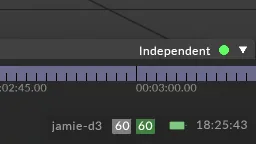Setup Editors
MultiEdit allows multiple people to edit a project simultaneously, without manually merging projects.
Edits from each machine are propagated to all other machines in real time. Each editor machine can work on a different track, or on different regions of the same track, at the same time; editors can also take control of the Director timeline position and control the stage.
There are a few ground rules for MultiEdit that must be observed:
The Director must be running
Section titled “The Director must be running”The Director machine is authority for show state; therefore, Designer must be running on the Director for a multiedit session to work. If you shut down Designer on the Director, all connected editors will be kicked out of the session. If you’re uncertain how to set up a Director/Actor read the setup d3net page.
The Director is the authority over show state
Section titled “The Director is the authority over show state”When an editor joins a session, it copies the project file over to the local machine. Any edits made on the local machine while it was offline will be overwritten. Therefore, if an editor makes edits to the project while disconnected, the only way to get the edits into the main project is to run a standard project merge.
Edits are first-come, first-serve
Section titled “Edits are first-come, first-serve”When an editor attempts to make a change to any object, it locks that object for a short time (a tenth of a second). During this time, if another editor tries to change that object, the change will be locked out. Locking is ‘fine-grained’ - it is, for example, possible for two people to edit different properties of the same layer at the same time; but edits to the same property will be first-come-first-served.
Director session control
Section titled “Director session control”The Director is the final authority on show state, and is responsible for show safety. Since unsupervised connection of editors at showtime introduces a risk, the Director has the ability to disallow any editors from connecting. It also has the ability to prevent editors from taking control of transport (the position of the cursor on the timeline). This is done using the network status widget on the Director.
Send Transport Commands
Section titled “Send Transport Commands”This means that Actors are following the Director’s timeline position. Clicking on this button changes the setting to disabled; show state will be propagated to Actors, but they will not follow if the Director jumps to a different part of a track, or jumps to a different track. This allows you to ‘park’ your Actors at a static position while editing continues on the Director.
Editors are allowed
Section titled “Editors are allowed”Means that editors are allowed to join the session. Clicking on this button changes the state to editors blocked; existing editors will be kicked off the session, and new editors will be disallowed.
Synchronising the project
Section titled “Synchronising the project”To join a session, the editor machine needs to first copy the entire project folder from the Director machine (including all media assets). Once this is done, the .d3 project file will be synchronised automatically; however any new media files must currently be synchronised manually using a third-party synchronisation utility.
Joining a session
Section titled “Joining a session”To join a session, open the d3Manager and find the project session in the project list. If the session is running, you’ll see the session icon next to the project name.

- Double-click the project to launch, and when prompted, choose Join Session.
Or alternatively;
- Right-click on the project name, and select Join Session. This will pop up a dialog box warning you that any local edits will be overwritten (they will be copied into the history folder, so they’re safe); clicking OK will start Designer in editor mode and synchronise the project file; you’ll see synchronising project file in the startup sequence.
For more options how to join a session see the Manager page.
Once you’re running, you’ll know you’re an editor if you see the independent button at the bottom right of the Disguise GUI.

Editing objects
Section titled “Editing objects”Once you’re in the session, you’ll find editing is pretty much the same as when you’re running as a Director or solo machine, with a couple of exceptions:
- You can’t edit the Director/Actor configuration itself.
- You can’t control any of the Director properties in the (dashboard).
Timeline control
Section titled “Timeline control”By default, the editor machine maintains its own transport position (position on timeline, and which track is selected). This means that you can freely jump from one track to another, making edits, without affecting the Director or the Actors. Sometimes, however, you’ll want to take control of the transport from the editor.

To do this, press the independent button on the timeline title bar. If the Director has allowed editors to take transport control (see Director session control above), the button will show locked to Director and flash green.
Clicking on a different bar of the track, pressing play/stop or next/prev section, or switching to another track, will be reflected on the Director and the Actors. Conversely, any transport control movements (including those generated by other editors, or external transport devices such as lighting desks or OSC) will be followed by the local editor machine, on a first-come, first-served basis.